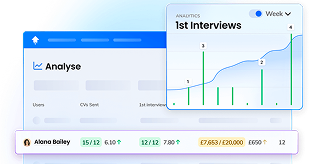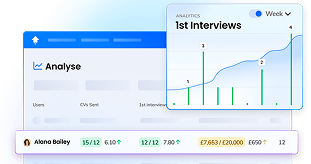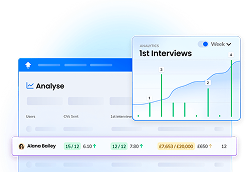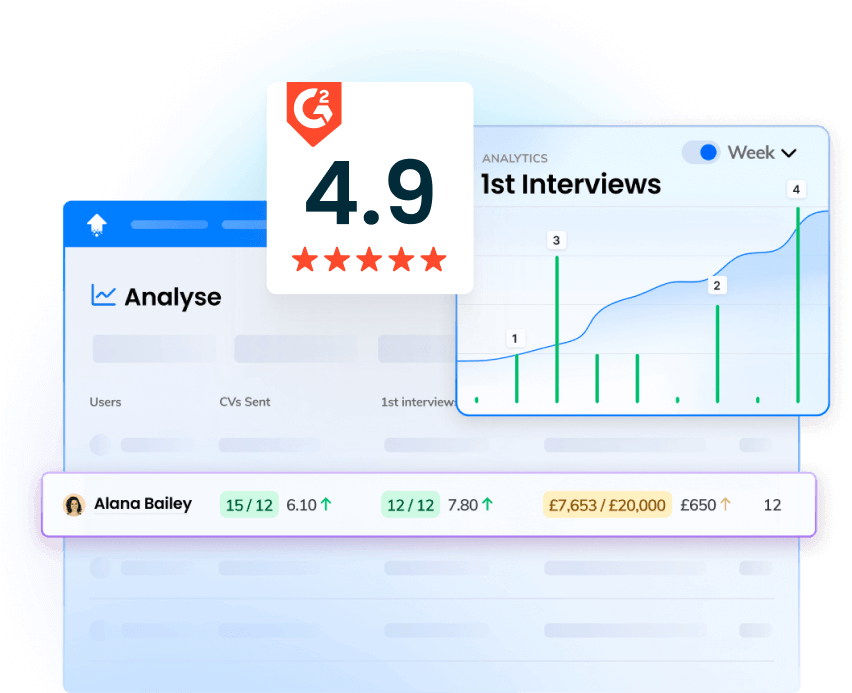Using Benchmark Data to Improve Recruitment Processes
So, now that you've browsed the benchmarking data above, how can you use this information to improve your hiring processes?
1. Identify Your Key Metrics
Which recruiting benchmark metrics will unlock success for your recruitment agency?
It's a big question.
To answer this, you'll need to consider your overall business strategy, your roadmap for the future, your recruitment strategy, and your agency's performance.
Every agency will benefit from tracking a number of recruiting KPI benchmarks, such as revenue per recruiter, jobs added, time to hire, or placements made.
In order to improve your hiring process, you'll want to track metrics at every stage of your funnel.
However, there will likely be additional metrics that your agency should focus on.
For example, if your hires' attrition rate is unusually high, you'll need to examine metrics like quality of hire and sourcing channel effectiveness.
Suppose the number of jobs added has been worryingly low for the past few months. In that case, it may be a good idea to delve deeper into metrics surrounding the effectiveness of business development calls.
2. Collect and Analyse Benchmarking Data
Once you've identified your key metrics, it's time to gather your data around those metrics.
For 2024, you can use the data within OneUp's recruiting metrics and performance benchmark report — State of Recruitment 2024 — saving you plenty of time around collection and analysis.
If you're conducting the recruitment industry benchmarking exercise in-house, look at competitive recruitment agencies and outstanding rivals you aspire to perform at the level of.
3. Consider Relevant Internal Data
Before launching into your goal-setting exercise, you also need to consider internal data and circumstances.
Remember, the point of this exercise is to create realistic and achievable yet ambitious goals.
So, if specific circumstances affect your agency, you should temper your goals accordingly.
For example, if one recruiter has taken an extended leave of absence, your average revenue per recruiter will likely be subdued.
Or perhaps you operate in a niche sector heavily impacted by world events or economic circumstances?
In these instances, you would need to lower your targets or change how you analyse the data to ensure your goals are achievable.
Alternatively, maybe your specialist sector is currently in extremely high demand due to new emerging tech — an advantage that your competitors do not have.
In this case, you could consider setting your goals significantly higher than the benchmarking data might suggest.
4. Set Your Goals
You've collected the data, crunched the numbers and it's finally time to set those all-important goals.
Every goal you set should be SMART:
- Specific
- Measurable
- Achievable
- Relevant
- Time-bound
Furthermore, every individual within your agency should be given goals to work towards.
Therefore, your goals will include:
- Business-wide goals
- Team goals
- Individual recruiter goals
For example, when looking at revenue metrics, your business-wide goal would be to generate £X amount of revenue within the next month, your team goal would be to generate £Y amount, and your individual recruiter goal would be to bring in £Z amount.
5. Track Goals
Now, you need to set up a system to track progress towards these goals.
Recruiting analytics software OneUp was designed for this very purpose.

To truly engage recruiters with their performance, it's essential that they are each able to easily access their real-time data.
Using OneUp, create custom dashboards for each recruiter that show their progress towards each goal they have been set.
Now, create custom team dashboards that display overall progress towards team goals.
Finally, set up a custom dashboard for the leadership team which shows overall progress towards business goals.
6. Dive Into the Data
Now your real-time data is organised into custom dashboards complete with intuitive visualisations, it's easy to regularly check progress towards your goals.
Vitally, this will also help you identify and swiftly resolve any issues with your processes.
For example, you may notice that a high number of CVs are being sent, but the first interview booked rate is significantly subdued. Then, delving into the data, it's possible to isolate this to one client.
You can then speak to recruiters to find out why this client has yet to book any interviews despite a high volume of CVs being sent, and if necessary, book a meeting with the hiring manager in question to discuss the issue.
7. Adapt and Improve
The overall results of your benchmarking exercise must be harnessed to adapt and improve your recruitment strategy and processes.
While real-time data allows you to implement quick fixes, as outlined above, the overall results from the time period you've tracked will give you essential insights.
Is your recruitment process as smooth as it can be?
Are there frequent bottlenecks in the hiring funnel?
Are your recruiters excelling at one task but underperforming at another?
The results should reveal exactly where issues exist within your recruitment strategy and processes — and identify how they can be rectified.
8. Do It All Again
Benchmarking is not a one-time thing.
Instead, it should be a continuous cycle of gathering and analysing data and then improving and adapting.
After all, you need to determine if your improvements have had the desired effect, while constant market shifts mean strategies must be regularly updated.
So when your current benchmarking time period is coming to an end, you need to start collecting and analysing the latest data for the next cycle.

































